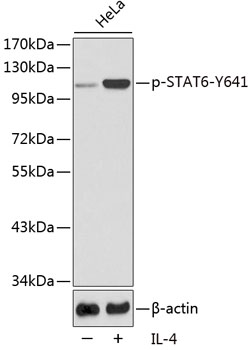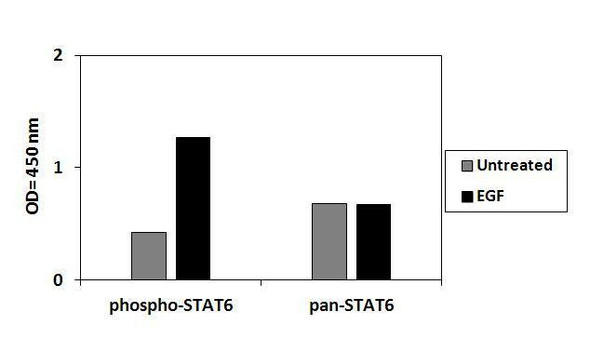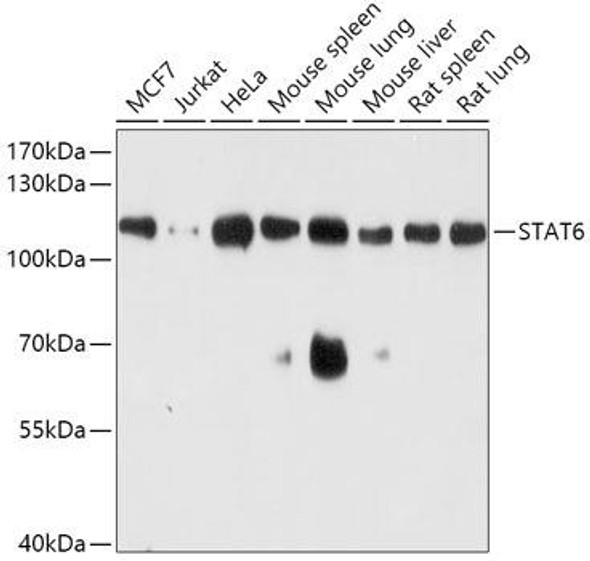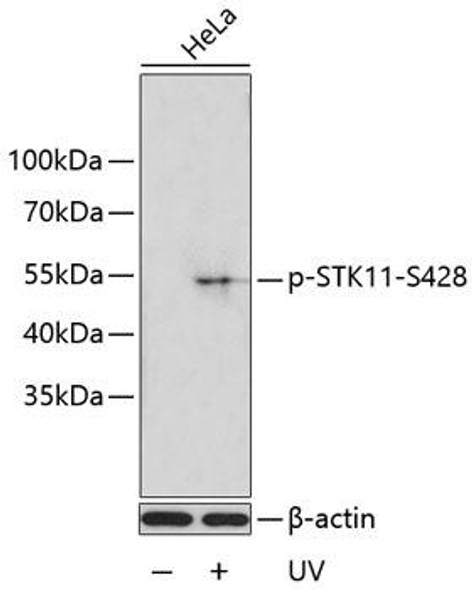Description
Anti-Phospho-STAT6-Y641 Antibody (CABP0456)
The Phospho-STAT6 (Y641) Polyclonal Antibody (CABP0456) is a powerful tool for researchers studying the phosphorylation of STAT6 at tyrosine 641, a key event in the activation of this transcription factor involved in immune responses.This polyclonal antibody, generated in rabbits, is highly specific for the phosphorylated form of STAT6 and is validated for use in various applications including Western blot, immunoprecipitation, and immunofluorescence. It binds to the phosphorylated tyrosine 641 residue of STAT6, allowing for the detection and analysis of this important signaling molecule in different cell types and experimental settings.
Phosphorylation of STAT6 at tyrosine 641 is known to be crucial for its transcriptional activity and function in regulating immune responses, making this antibody an essential tool for studying the role of STAT6 in immune modulation and diseases such as allergy, asthma, and inflammatory conditions. By understanding the phosphorylation status of STAT6, researchers can gain valuable insights into the mechanisms underlying immune regulation and develop novel therapeutic strategies targeting this pathway.
| Antibody Name: | Anti-Phospho-STAT6-Y641 Antibody |
| Antibody SKU: | CABP0456 |
| Antibody Size: | 20uL, 50uL, 100uL |
| Application: | WB |
| Reactivity: | Human |
| Host Species: | Rabbit |
| Immunogen: | A phospho specific peptide corresponding to residues surrounding Y641 of human STAT6 |
| Application: | WB |
| Recommended Dilution: | WB 1:500 - 1:2000 |
| Reactivity: | Human |
| Positive Samples: | HeLa |
| Immunogen: | A phospho specific peptide corresponding to residues surrounding Y641 of human STAT6 |
| Purification Method: | Affinity purification |
| Storage Buffer: | Store at -20°C. Avoid freeze / thaw cycles. Buffer: PBS with 0.02% sodium azide, 50% glycerol, pH7.3. |
| Isotype: | IgG |
| Sequence: | Email for sequence |
| Gene ID: | 6778 |
| Uniprot: | P42226 |
| Cellular Location: | Cytoplasm, Nucleus |
| Calculated MW: | 74kDa/81kDa/94kDa |
| Observed MW: | 110kDa |
| Synonyms: | D12S1644, IL-4-STAT, STAT6B, STAT6C, STAT6 |
| Background: | The protein encoded by this gene is a member of the STAT family of transcription factors. In response to cytokines and growth factors, STAT family members are phosphorylated by the receptor associated kinases, and then form homo- or heterodimers that translocate to the cell nucleus where they act as transcription activators. This protein plays a central role in exerting IL4 mediated biological responses. It is found to induce the expression of BCL2L1/BCL-X(L), which is responsible for the anti-apoptotic activity of IL4. Knockout studies in mice suggested the roles of this gene in differentiation of T helper 2 (Th2) cells, expression of cell surface markers, and class switch of immunoglobulins. Alternative splicing results in multiple transcript variants. |
| UniProt Protein Function: | STAT6: transcription factor of the STAT family. Plays a central role in IL4-mediated biological responses. Induces the expression of BCL2L1/BCL-X(L), which is responsible for the anti-apoptotic activity of IL4. May function in the differentiation of T helper 2 cells and class switch of immunoglobulins. Forms homo- or heterodimers that translocate into the nucleus where they regulate transcription. |
| UniProt Protein Details: | Protein type:DNA-binding; Transcription factor Chromosomal Location of Human Ortholog: 12q13 Cellular Component: cytoplasm; cytosol; lipid raft; nuclear chromatin; nucleoplasm Molecular Function:identical protein binding; protein binding; protein phosphatase binding; signal transducer activity; transcription factor activity Biological Process: mammary gland epithelial cell proliferation; negative regulation of T-helper 2 type immune response; negative regulation of transcription from RNA polymerase II promoter; positive regulation of interferon type I production; positive regulation of isotype switching to IgE isotypes; positive regulation of transcription from RNA polymerase II promoter; regulation of cell proliferation; regulation of transcription from RNA polymerase II promoter; signal transduction; T-helper 1 cell lineage commitment; transcription, DNA-dependent |
| NCBI Summary: | The protein encoded by this gene is a member of the STAT family of transcription factors. In response to cytokines and growth factors, STAT family members are phosphorylated by the receptor associated kinases, and then form homo- or heterodimers that translocate to the cell nucleus where they act as transcription activators. This protein plays a central role in exerting IL4 mediated biological responses. It is found to induce the expression of BCL2L1/BCL-X(L), which is responsible for the anti-apoptotic activity of IL4. Knockout studies in mice suggested the roles of this gene in differentiation of T helper 2 (Th2) cells, expression of cell surface markers, and class switch of immunoglobulins. Alternative splicing results in multiple transcript variants.[provided by RefSeq, May 2010] |
| UniProt Code: | P42226 |
| NCBI GenInfo Identifier: | 1174459 |
| NCBI Gene ID: | 6778 |
| NCBI Accession: | P42226.1 |
| UniProt Secondary Accession: | P42226,Q5FBW5, Q71UP4, A8K316, B7ZA27, F5GXI9, |
| UniProt Related Accession: | P42226 |
| Molecular Weight: | |
| NCBI Full Name: | Signal transducer and activator of transcription 6 |
| NCBI Synonym Full Names: | signal transducer and activator of transcription 6 |
| NCBI Official Symbol: | STAT6 |
| NCBI Official Synonym Symbols: | STAT6B; STAT6C; D12S1644; IL-4-STAT |
| NCBI Protein Information: | signal transducer and activator of transcription 6 |
| UniProt Protein Name: | Signal transducer and activator of transcription 6 |
| UniProt Synonym Protein Names: | IL-4 Stat |
| Protein Family: | Signal transducer and transcription activator |
| UniProt Gene Name: | STAT6 |
| UniProt Entry Name: | STAT6_HUMAN |













